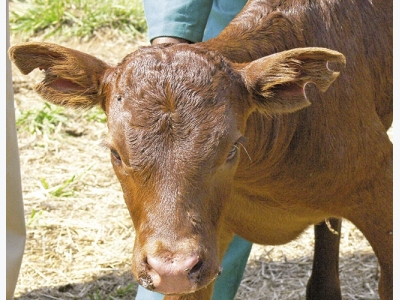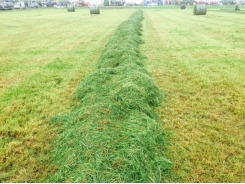Tattooing and ear notching techniques

Here are two tried-and-tested alternative permanent marking techniques that are suitable for both large and small livestock. Each has its distinctive advantages and disadvantages.
While most commonly used in the pig industry, ear notching can be used for all species of livestock. Photo: Chris Nel
Tattooing and ear notching are widely used techniques to mark livestock. Each has its own advantages, disadvantages, application techniques and specific uses.
Tattooing
Tattooing is a marking technique in which a permanent mark is placed in an unobtrusive area such as on the ear of an animal.
It consists of a pattern of closely-spaced dark dots depicting numbers, letters or a combination of the two, imbedded in the bare skin using black ink, generally on the inside of the ear.
If properly done, a tattoo is as distinctive and permanent as a brand and complies with the requirements of both animal identification legislation and breed regulations.
The tattoo will be legible and permanent if the correct equipment, permanent tattoo ink and procedure is used. Inferior quality ink can be absorbed into the bloodstream, causing it fade.
Tattoo equipment
Tattoo pliers are designed to accommodate a combination of easy-change standard 3/8” character dies that cannot be inserted upside down.
The dies contain sharp, nickel-plated steel needles set in a fiberglass reinforced nylon base and are available as numbers and letters.
A pair of pliers, character dies and ink are some of the tools needed for tattooing livestock.
The needles pierce the skin to make clear and readable marks.
Black tattoo ink is used for normal use and green tattoo ink for animals with a black or darkly pigmented skin.
Tattoo procedure
- Place the tattoo character dies (letters and/or numbers) in the appropriate sequence and position in the pliers.
- Check that the tattoo is correct by testing on a piece of cardboard or other similar surface.
- Clean the fat/wax layer off the ear surface with alcohol and remove any hair. When tattooing piglets, clean the outside of the ear.
- If you are new to this technique, place a rubber ear-release stripper over the tattoo dies and close the pliers. Place a second stripper over the first. The pins should be visible through the rubber stripper material, which acts as a spacer and prevents the ear from remaining stuck to the tattoo needles.
- Slip the pliers over the ear in the position where the tattoo is to be placed.
- Close the pliers with a quick, firm motion so that the tattoo character pins pierce through the ear. Open the pliers immediately and remove.
- Spread a small amount of tattoo ink on the tattoo area and rub it into the holes made by the pins.
- The excess ink will fade in time, while the ink in the holes of the tattoo will leave a permanent mark when the skin recovers. Tattooing ink has antiseptic properties that promote healing.
- After use, clean and dry the pliers and dies with a soft brush in water containing liquid dishwashing detergent. Do not use harsh solvents. Dry with a hair dryer.
- Store equipment in a clean, dry place.
Advantages of tattooing
- It is as permanent as a brand.
- As with a brand, it is only applied once in an animal’s lifetime.
- If the correct tools and material is used, it is simpler and quicker than branding and requires less preparation and infrastructure.
- It can be used on animals of any age, whether small or large stock.
- The cost is lower than branding, in terms of equipment, consumables and time.
- It is unobtrusive, which can also be a disadvantage.
- It can be used by itself, or as a backup to other identification systems.
- The animal’s skin is damaged less than with branding.
- The material, a biologically inactive ink, has no effect on the animal.
- The animal experiences less pain and stress than with branding.
- It is suitable for all livestock – cattle, sheep, goats, horses, pigs, game animals, and even dogs.
- The equipment is far more portable and can be carried in a small case or bag.
- It is legally acceptable.
Disadvantages of tattooing
- It is inconspicuous and requires close examination to read. The animal generally has to be restrained in a crush, passage or neck clamp.
- It works less well with darkly pigmented animals and animals with woolly ears.
- The animal has to be restrained when being tattooed, similarly but less so than when branding.
- Defacing or altering is easier and less obvious than with a brand.
- The chance of infection or disease transmission from one animal to another exists, but can be reduced with proper hygiene and correct technique.
Ear notching
Ear notching is a simple and handy method to identify animals individually from a distance.
There are variations in systems, but each identifies the animal by an individual number expressed in the relative positions of a combination of notches in the ear rim. It can be used for all livestock species, but is particularly common in the pig industry.
It involves removing V-shaped or U-shaped portions of the ear rim in a specific and individual combination of positions, using a special ear notching pair of pliers. A sharp knife gives less predictable and controllable results.
Thus no two animals will have the same combination of notches. Not all operations may find it necessary to use individual numbers, but individual numbers are needed when any animal has to be recognised separately from others. Other marking systems may be used in combination with ear notches.
A variation of this technique is ear punching, in which holes are punched through the ear shell, using a pair of hole punch pliers.
Advantages of ear notching
- It is permanent.
- It is relatively quick and simple.
- Notches are highly visible. Holes are only really visible against the light.
- High numbers are possible.
- No consumables are needed.
Disadvantages of ear notching
- A large area of the ear shell could be removed. With holes, this is less likely.
- There is an increased chance of errors, mismarking and misreading, especially initially with inexperienced staff.
- Accidental defacing through injury or deliberate action on stolen animals is a risk.
- It is not legally acceptable.
- With acknowledgement to SAVET and Ketchum Manufacturing Inc.
Related news
Tools

Phối trộn thức ăn chăn nuôi

Pha dung dịch thủy canh

Định mức cho tôm ăn

Phối trộn phân bón NPK

Xác định tỷ lệ tôm sống

Chuyển đổi đơn vị phân bón

Xác định công suất sục khí

Chuyển đổi đơn vị tôm

Tính diện tích nhà kính

Tính thể tích ao



 The best dairy breed: A comparative study
The best dairy breed: A comparative study  Dealing with clostridial diseases (2)
Dealing with clostridial diseases (2)